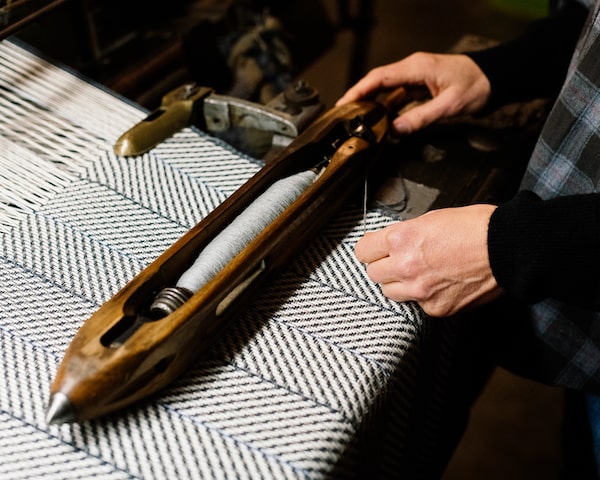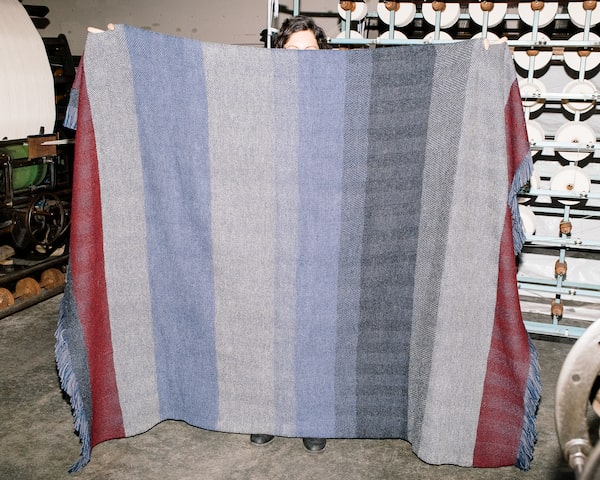
The revival of Canadian-made textiles starts with small producers sharing their passion for their craft. In B.C., Macgee Cloth Company creates beautiful blankets that do just that.alana paterson/The Globe and Mail
In the small, Sunshine Coast community of Roberts Creek, B.C., sits a shed, hidden among majestic firs, where the rhythmic thump and clank of an antique shuttle loom can be heard at all hours of the day and night.
Inside, the woman oiling the gears, changing the bobbins and pulling the levers is Pam Magee, a part-time pharmacist-turned-heirloom weaver. Six years ago, she found a 1936 English Dobcross shuttle loom in a sheep pasture in Wales and had it shipped in hundreds of pieces to her home. In 2019, she created the first custom blanket under her label, The Macgee Cloth Company. Since then, her blankets, made from the finest ethically sourced cotton and wool, have become cherished keepsakes by those who appreciate their provenance – as well as the pluck of a woman determined to breathe new life into a venerable craft.
Style Advisor November 2021 edition: Stylish inspiration for your holiday gift giving

Pam Magee was a part-time pharmacist before becoming a heirloom weaver. She says her passion for woven textiles grew out of a fascination for turn-of-the-century loom technology.alana paterson/The Globe and Mail
“I was lucky enough to see one of these beauties in full flight while on vacation in Spain many years ago and I became somewhat obsessed,” Magee says. When her loom arrived, she built a workshop next to her house to store it and then started the complicated reassembly.
“There is no handbook to look up on the internet to tell you how to fix it and run it,” she says. “I had a couple old manuals and help from a friend named Howard, who had operated the looms as a boy in Yorkshire.” The two of them spent hours meeting on Zoom and Skype to put the pieces back together and work out the many kinks. Soon after, she purchased another hulking piece of equipment, a 1899 Charlesworth warper (believed to be the only one still in existence) that takes the threads off the rack of spools, in even lengths and tension, to form the vertical part of the weave, known as the warp.
“My passion for woven textiles grew out of a fascination for turn-of-the-century loom technology that once revolutionized textile production. To see and hear these machines in action, to smell 100-year-old grease, is an experience akin to time travel,” Magee says. “This allure, paired with an increasing frustration over the lack of transparency in textile manufacturing and the absence of a textile industry in Canada, is what compelled me to set up this little company.”
To understand the impact of these looms on the world’s textile industry, one has to look back roughly 100 years. The industrial shuttle loom sped up textile production and made quality cloth accessible to the average person rather than just society’s well-to-do.

"To see and hear these machines in action, to smell 100-year-old grease, is an experience akin to time travel,” Magee says of working with her loom.alana paterson/The Globe and Mail

Each blanket takes about 40 minutes to weave. The washing, finishing and pressing – all done by Magee – can add two-to-three additional days to her production timeline.alana paterson/The Globe and Mail
The shuttle loom is special for another reason. Unlike the next phase of loom innovation (such as the rapier loom used in textile mills in Europe, Asia and the U.S. today), the shuttle loom creates a continuous weft thread as it circles the edge of the bobbin, creating a true selvedge – or “self-finished” edge – which prevents fraying or ravelling. “The selvedge edge was lost by gaining speed,” Magee says.
When it comes to the fibres she chooses for her blankets and throws, Magee focuses on full transparency and traceability. Her cotton comes from Hill Spinners in North Carolina, which buys its cotton from the Texas Organic Cotton Marketing Cooperative. Its members primarily practice dryland farming, which means they don’t irrigate but rely on rain cycles and reservoirs. The 100-per-cent lambswool is produced and spun at Gledhill Spinners, which has been in operation in Yorkshire since 1777.

When it comes to the fibres she chooses for her blankets and throws, Magee focuses on full transparency and traceability.alana paterson/The Globe and Mail
Each blanket takes about 40 minutes to weave. The washing, finishing and pressing – all done by Magee – can add two-to-three additional days to her production timeline. The blankets, which range from $400 to $700, are sold online and at Inform Interiors in Vancouver.
“My biggest challenge at the moment is getting to the next level,” says Magee, who is the sole owner and operator of her little back-in-the-woods operation. “And I’m no spring chicken.” Her hope is that the beauty of her blankets will inspire younger artisans to pick up the craft and carry the storied tradition of heirloom weaving forward. “I’m hoping to grow it into something that will benefit my community, young people and Canada. To help us create a textile world, which we once had, but we let disappear.”

Since making her first blanket in 2019, Magee's textiles have become cherished keepsakes by those who appreciate their provenancealana paterson/The Globe and Mail




 Gayle MacDonald
Gayle MacDonald